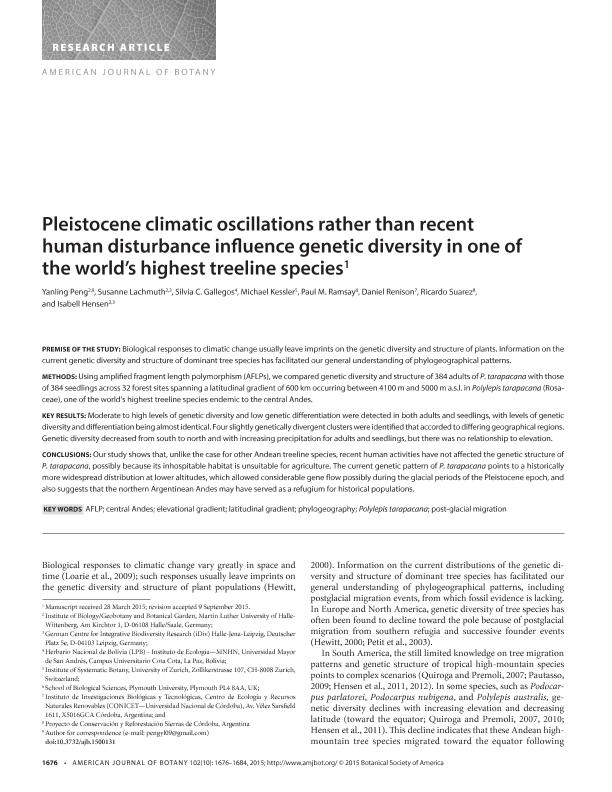Mostrar el registro sencillo del ítem
dc.contributor.author
Peng, Yanling
dc.contributor.author
Lachmuth, Susanne
dc.contributor.author
Gallegos, Silvia C.
dc.contributor.author
Kessler, Michael
dc.contributor.author
Ramsay, Paul M.
dc.contributor.author
Renison, Daniel

dc.contributor.author
Suarez, Ricardo
dc.contributor.author
Hensen, Isabell
dc.date.available
2018-03-13T19:18:09Z
dc.date.issued
2015-10
dc.identifier.citation
Peng, Yanling; Lachmuth, Susanne; Gallegos, Silvia C.; Kessler, Michael; Ramsay, Paul M.; et al.; Pleistocene climatic oscillations rather than recent human disturbance influence genetic diversity in one of the world’s highest treeline species; Botanical Society of America; American Journal of Botany; 102; 10; 10-2015; 1676-1684
dc.identifier.issn
0002-9122
dc.identifier.uri
http://hdl.handle.net/11336/38682
dc.description.abstract
PREMISE OF THE STUDY: Biological responses to climatic change usually leave imprints on the genetic diversity and structure of plants. Information on the current genetic diversity and structure of dominant tree species has facilitated our general understanding of phylogeographical patterns. METHODS: Using amplified fragment length polymorphism (AFLPs), we compared genetic diversity and structure of 384 adults of P. tarapacana with those of 384 seedlings across 32 forest sites spanning a latitudinal gradient of 600 km occurring between 4100 m and 5000 m a.s.l. in Polylepis tarapacana (Rosaceae), one of the world’s highest treeline species endemic to the central Andes. K EY RESULTS: Moderate to high levels of genetic diversity and low genetic differentiation were detected in both adults and seedlings, with levels of genetic diversity and differentiation being almost identical. Four slightly genetically divergent clusters were identified that accorded to differing geographical regions. Genetic diversity decreased from south to north and with increasing precipitation for adults and seedlings, but there was no relationship to elevation. CONCLUSIONS: Our study shows that, unlike the case for other Andean treeline species, recent human activities have not affected the genetic structure of P. tarapacana, possibly because its inhospitable habitat is unsuitable for agriculture. The current genetic pattern of P. tarapacana points to a historically more widespread distribution at lower altitudes, which allowed considerable gene flow possibly during the glacial periods of the Pleistocene epoch, and also suggests that the northern Argentinean Andes may have served as a refugium for historical populations.
dc.format
application/pdf
dc.language.iso
eng
dc.publisher
Botanical Society of America

dc.rights
info:eu-repo/semantics/openAccess
dc.rights.uri
https://creativecommons.org/licenses/by-nc-sa/2.5/ar/
dc.subject
Aflp
dc.subject
Central Andes
dc.subject
Elevational Gradient
dc.subject
Latitudinal Gradient
dc.subject
Phylogeography
dc.subject
Polylepis Tarapacana
dc.subject
Post-Glacial Migration
dc.subject.classification
Otras Ciencias Biológicas

dc.subject.classification
Ciencias Biológicas

dc.subject.classification
CIENCIAS NATURALES Y EXACTAS

dc.title
Pleistocene climatic oscillations rather than recent human disturbance influence genetic diversity in one of the world’s highest treeline species
dc.type
info:eu-repo/semantics/article
dc.type
info:ar-repo/semantics/artículo
dc.type
info:eu-repo/semantics/publishedVersion
dc.date.updated
2018-03-07T18:39:25Z
dc.journal.volume
102
dc.journal.number
10
dc.journal.pagination
1676-1684
dc.journal.pais
Estados Unidos

dc.description.fil
Fil: Peng, Yanling. Martin Luther University of Halle-Wittenberg; Alemania
dc.description.fil
Fil: Lachmuth, Susanne. Martin Luther University of Halle-Wittenberg; Alemania
dc.description.fil
Fil: Gallegos, Silvia C.. Universidad Mayor de San Andrés; Bolivia
dc.description.fil
Fil: Kessler, Michael. Universitat Zurich; Suiza
dc.description.fil
Fil: Ramsay, Paul M.. Plymouth University; Reino Unido
dc.description.fil
Fil: Renison, Daniel. Consejo Nacional de Investigaciones Científicas y Técnicas. Centro Científico Tecnológico Conicet - Córdoba. Instituto de Investigaciones Biológicas y Tecnológicas. Universidad Nacional de Córdoba. Facultad de Ciencias Exactas, Físicas y Naturales. Instituto de Investigaciones Biológicas y Tecnológicas; Argentina
dc.description.fil
Fil: Suarez, Ricardo. Proyecto de Conservación y Reforestación Sierras de Córdoba; Argentina
dc.description.fil
Fil: Hensen, Isabell. Martin Luther University of Halle-Wittenberg; Alemania
dc.journal.title
American Journal of Botany

dc.relation.alternativeid
info:eu-repo/semantics/altIdentifier/doi/http://dx.doi.org/10.3732/ajb.1500131
dc.relation.alternativeid
info:eu-repo/semantics/altIdentifier/url/http://onlinelibrary.wiley.com/doi/10.3732/ajb.1500131/abstract
Archivos asociados
